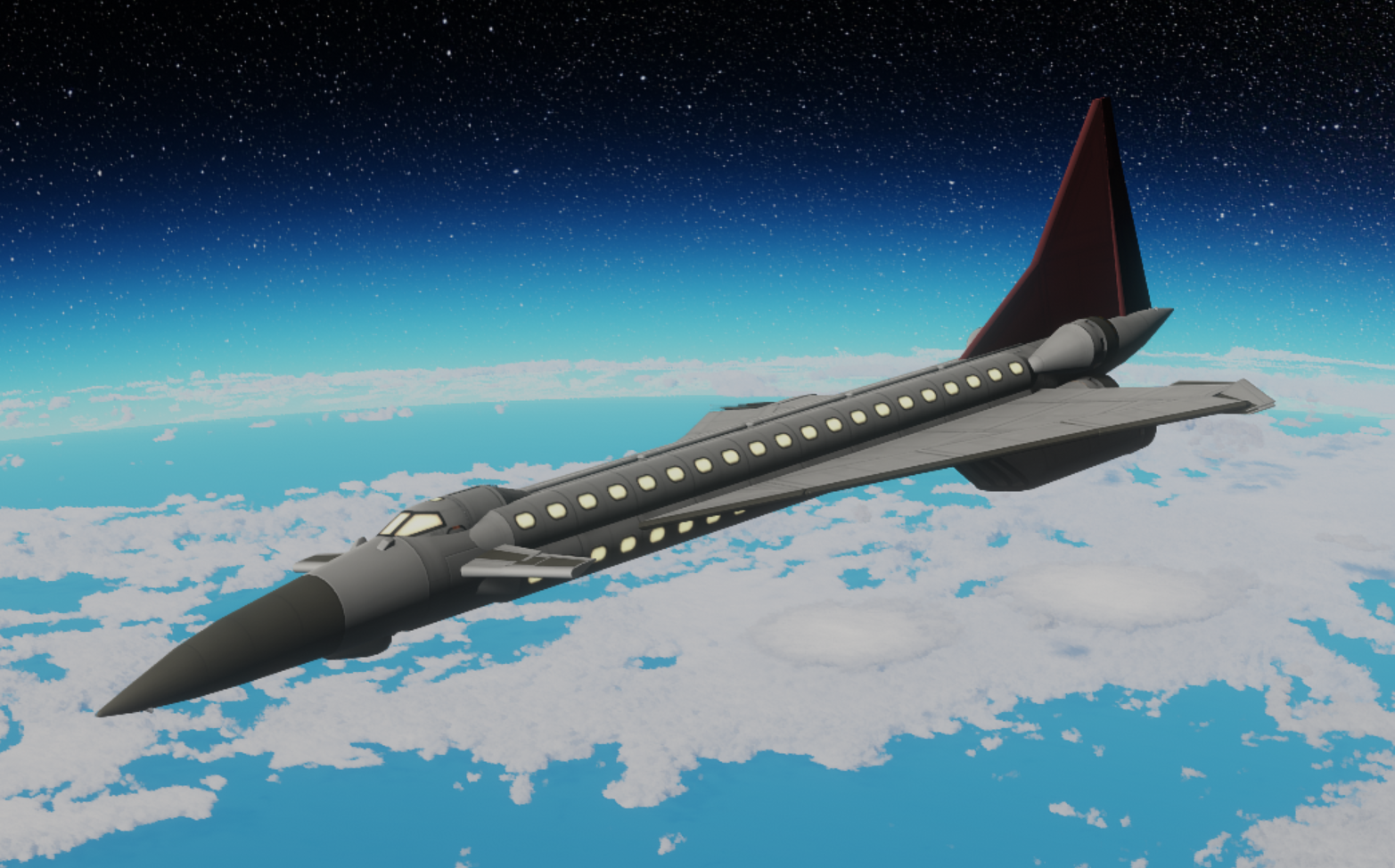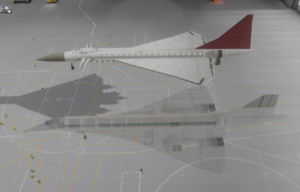TSA-144: Difference between revisions
Slavic blin (talk | contribs) mNo edit summary |
Slavic blin (talk | contribs) mNo edit summary |
||
| (3 intermediate revisions by the same user not shown) | |||
| Line 18: | Line 18: | ||
===Materials=== |
===Materials=== |
||
| − | The aircraft was designed for 20 years of service and with it 120 reentries. 51,500 tiles glued to the airframe make up the exterior, with significant gaps to account for thermal expansion. |
+ | The aircraft was designed for 20 years of service and with it 120 reentries. Aluminium alloys were first proposed but proved to perform poorly at mach speeds above 2. 51,500 tiles glued to the airframe make up the exterior, with significant gaps to account for thermal expansion. The top and rear of the aircraft uses thermal blankets in the place of tiles, and the nose, leading edge of the wing, and engines are reinforced with a carbon-carbon material as these areas take the majority of the heating. |
===Engines=== |
===Engines=== |
||
| − | The developement of the SHASHKA engine was the longest and most drawn out process, and the end result was still inferior to foreign airbreathing rockets. The poor performance of the engines neccesitated increasing the number from 4 to 8, with the extra 4 placed on the tail being fed through the wings and into the rear fueselage. Research into possible ways to upgrade the SHASHKA is ongoing which leads many to suspect industrial espionage is still underway. |
+ | The developement of the SHASHKA engine was the longest and most drawn out process, and the end result was still inferior to foreign airbreathing rockets. The poor performance of the engines neccesitated increasing the number from 4 to 8, with the extra 4 placed on the tail being fed through the wings and into the rear fueselage. Research into possible ways to upgrade the SHASHKA is ongoing which leads many to suspect industrial espionage is still underway. |
| + | ===Cabin=== |
||
| + | The cabin of the TSA-144 is effectively populated with crash couches adapted from space capsules bunked on top of eachother resulting in a cramped accomadation. The cabin is extensively noisy while the engines are active. Concerns of comfort were not considered significant as passengers are only expected to spend 4 hours at most in the craft before offloading to a ship in LKO. |
||
| + | |||
==Accidents and Incidents== |
==Accidents and Incidents== |
||
the only accidents were engineers stubbing their feet on components in the hangar. |
the only accidents were engineers stubbing their feet on components in the hangar. |
||
==See also== |
==See also== |
||
| − | '''Aircraft of Comparable Role, Configuration, and Era''' |
+ | '''Aircraft of Comparable Role, Configuration, and Era'''<br> |
| + | [[Konkorde]] <br> |
||
| + | [[OS-57 Valk]] |
||
| + | |||
[[Category:Aircraft]] |
[[Category:Aircraft]] |
||
[[Category:Passenger Aircraft]] |
[[Category:Passenger Aircraft]] |
||
| + | [[Category:Spacecraft]] |
||
Latest revision as of 23:08, 10 July 2024
|
TSA-144
|
|||||
|---|---|---|---|---|---|
| SSTO Airliner | |||||
 |
|||||
| TSA-144 in orbit on it's first orbital test flight. Note the lack of the communications mast and solar panels now present on the aircraft. | |||||
| National Origin | Sahr/Bastia | ||||
| Production History | |||||
| Designer | Tsaregorodtsev Aviation | ||||
| Unit Cost | 71595(√) | ||||
| Number Built | 1 | ||||
| Service History | |||||
| Used By | Tsaregorodtsev Aviation | ||||
TSA-144 is a Sahren prototype SSTO under developement by Tsaregorodtsev Aviation. Developement began in 2167, with signiciant evident of industrial espionage of the Konkorde. construction began in 2189 after 21 years of studies and delays. Only one prototype has flown due to low demand, but it is still used as a testbed for aerospace technologies.
Background
With greater participation in the Aontan federal system after the Hysteria of 2160, Sahrens became involved in Aontan space industry. By 2167 plans were drawn up by Tsaregorodtsev Aviation and Abzalev Design Bereau for a large scale SSTO passenger aircraft.
Developement & Controversy
Commonard designers were hopeful that many components could be aided or directly copied from Cyten-Ward Industries, especially given that Bastia saw significant Zokesian investment and was also the home of the Tsar aviation testing facility. Although it has often been claimed a direct copy of the Konkorde, comparitively little information was actually gained in the espionage programme.
As Abzalev dropped out of the programme early on, to make up on lost funds they agreed to sell patents to components of the Alkan type 2172 turbojet, with the Republican Guard air-corp refusing to let them sell the entire engine. Tech leaks from Cyten-Ward aided the construction of the air intakes. Even with these the SHASHKA engines effectively needed to be designed from scratch as airbreathing rockets were never domestically produced by any Sahren corporation. Wing and fuelselage shape were significantly influenced by the Konkorde, though several aspects of a tailless design were considered unreliable resulting in the all-moving wingtips and implementation of canards.
The goals of the aircraft were to reach low kerbin orbit with at least 300m/s of delta-v to spare for maneuvers, while carrying 120 passengers. In reality only 80 passengers could be fitted in such a small fuelselage though it was able to exceed the delta-v limit.
Design
TSA-144 is an elevatorless design with moustache canards capable of carrying 80 passengers in a cramped configuration. It is powered by eight SHASHKA engines with two adjustable ram intakes. It is crewed by only one pilot and one copilot, and lacks the distinct droop snoot of the often compared Konkorde. For landing the pilot is effectively blind apart from instrumentation and a low resolution camera on the underside. Although it looks nearly identical to the Konkorde, it is longer, has a wider wingspan, and larger engine nacelles along with double the amount of engines.
Materials
The aircraft was designed for 20 years of service and with it 120 reentries. Aluminium alloys were first proposed but proved to perform poorly at mach speeds above 2. 51,500 tiles glued to the airframe make up the exterior, with significant gaps to account for thermal expansion. The top and rear of the aircraft uses thermal blankets in the place of tiles, and the nose, leading edge of the wing, and engines are reinforced with a carbon-carbon material as these areas take the majority of the heating.
Engines
The developement of the SHASHKA engine was the longest and most drawn out process, and the end result was still inferior to foreign airbreathing rockets. The poor performance of the engines neccesitated increasing the number from 4 to 8, with the extra 4 placed on the tail being fed through the wings and into the rear fueselage. Research into possible ways to upgrade the SHASHKA is ongoing which leads many to suspect industrial espionage is still underway.
Cabin
The cabin of the TSA-144 is effectively populated with crash couches adapted from space capsules bunked on top of eachother resulting in a cramped accomadation. The cabin is extensively noisy while the engines are active. Concerns of comfort were not considered significant as passengers are only expected to spend 4 hours at most in the craft before offloading to a ship in LKO.
Accidents and Incidents
the only accidents were engineers stubbing their feet on components in the hangar.
See also
Aircraft of Comparable Role, Configuration, and Era
Konkorde
OS-57 Valk
